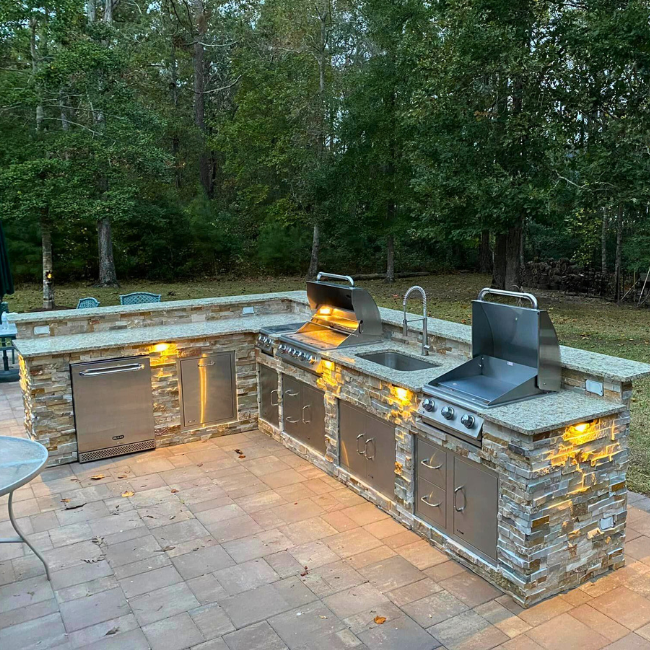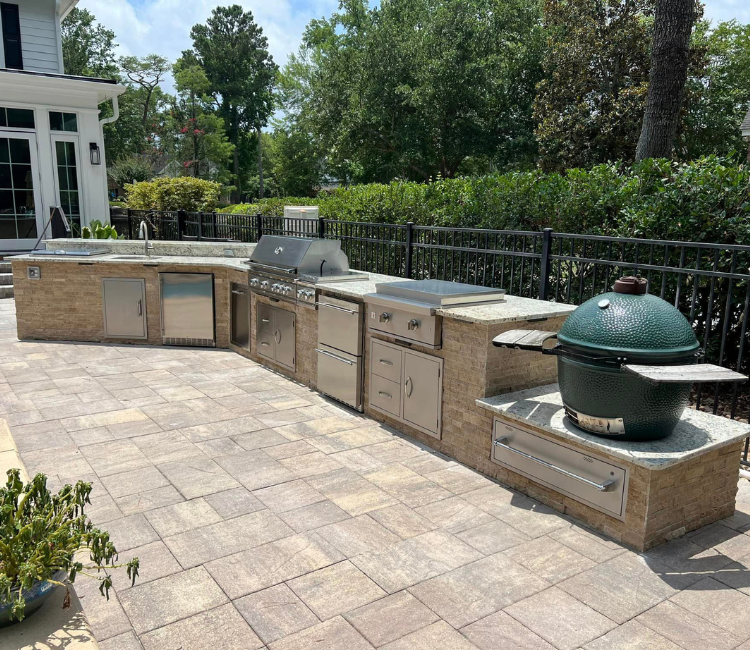
Soundscaping: How to Design an Immersive Outdoor Audio Environment
March 24, 2025
Finding the Perfect Balance of Shade and Sun with Automated Pergolas
May 30, 2025Living by the coast brings plenty of perks — ocean breezes, stunning views and relaxed vibes. However, the salty air can wreak havoc on outdoor spaces if the right materials aren’t used. When designing durable outdoor kitchens, especially in areas like Myrtle Beach, it’s critical to choose materials that can stand up to humidity, salt and sun exposure without losing their beauty or function.
Best Materials for Designing Durable Outdoor Kitchens
1. Stainless Steel: The Gold Standard
Stainless steel is a top choice for outdoor kitchens near the ocean. Look for marine-grade 316 stainless steel, which contains molybdenum for added corrosion resistance. It holds up beautifully against salt exposure, delivers a sleek look and is easy to clean — exactly what you need in a busy outdoor cooking area.
2. High-Quality Stone and Concrete Countertops
For surfaces that need to survive both heat and salt air, natural stone options like granite or carefully sealed concrete are excellent. They offer incredible durability and timeless beauty. Choose lighter colors to reflect the sun’s heat and reduce temperature buildup around your cooking stations.
3. Powder-Coated Aluminum Cabinets
Cabinetry made from powder-coated aluminum is another smart pick for coastal outdoor kitchens. It resists rust, peeling and fading far better than painted wood or untreated metal. Plus, powder-coated surfaces come in a variety of colors and textures to match your outdoor design dreams.
4. Weather-Resistant Flooring Options
Flooring needs to be tough and slip-resistant. Options like porcelain tile, sealed pavers and textured stone can handle coastal moisture and salt without becoming slippery or deteriorating. They also add a polished look to tie the whole outdoor kitchen space together.
5. Choosing the Right Fixtures and Hardware
Even the little details matter when designing durable outdoor kitchens. Always choose marine-grade stainless steel for hardware like drawer handles, hinges and faucets. Avoid cheaper metals that could quickly corrode and spoil your investment.
Why Smart Material Choices Matter
Using the wrong materials in a coastal outdoor kitchen could lead to rapid deterioration, costly repairs and major headaches. By planning carefully and choosing durable, weather-resistant elements from the start, you protect your outdoor kitchen’s beauty, functionality and value for years to come.
Designing durable outdoor kitchens in coastal regions means more than picking stylish appliances and countertops — it’s about making smart material choices that can handle the unique challenges of salty, humid air. At Outdoor Living Inc., we specialize in creating stunning outdoor kitchens built to last along the Grand Strand. Ready to start building your dream outdoor space? Contact us today, and let’s create something amazing together!
FAQs
1. What are the best materials for an outdoor kitchen near the ocean?
When building an outdoor kitchen near the ocean, it’s crucial to choose materials that resist corrosion, fading and moisture damage. The top choices include marine-grade 316 stainless steel for appliances and cabinetry, sealed granite or porcelain for countertops and weather-resistant flooring like porcelain tile or textured pavers. These materials hold up well against salty air, high humidity and intense sun, giving you a long-lasting and beautiful outdoor kitchen.
2. How do you protect an outdoor kitchen from salt air?
Protecting an outdoor kitchen from salt air starts with smart material choices. Use corrosion-resistant metals like marine-grade stainless steel and powder-coated aluminum. Regular maintenance is also key: rinse surfaces with fresh water every few weeks to wash away salt buildup, keep hardware and hinges lubricated and re-seal stone countertops annually to block out moisture and salt intrusion. These simple steps will extend the life and appearance of your outdoor kitchen dramatically.
3. Can you use wood in a coastal outdoor kitchen?
While wood adds warmth and style, it is generally not the best choice for coastal outdoor kitchens unless it’s a highly durable and treated wood like teak or ipe. Even then, regular sealing and maintenance are required to prevent warping, cracking and decay from moisture and salt exposure. Most homeowners in coastal areas choose alternatives like powder-coated aluminum or composite materials that mimic the look of wood without the vulnerability.




